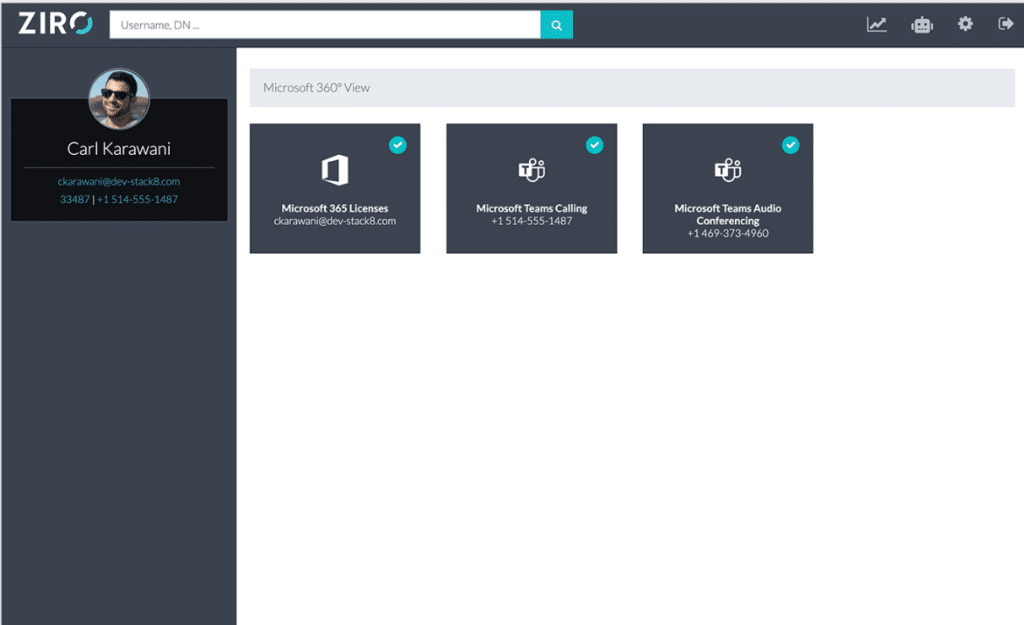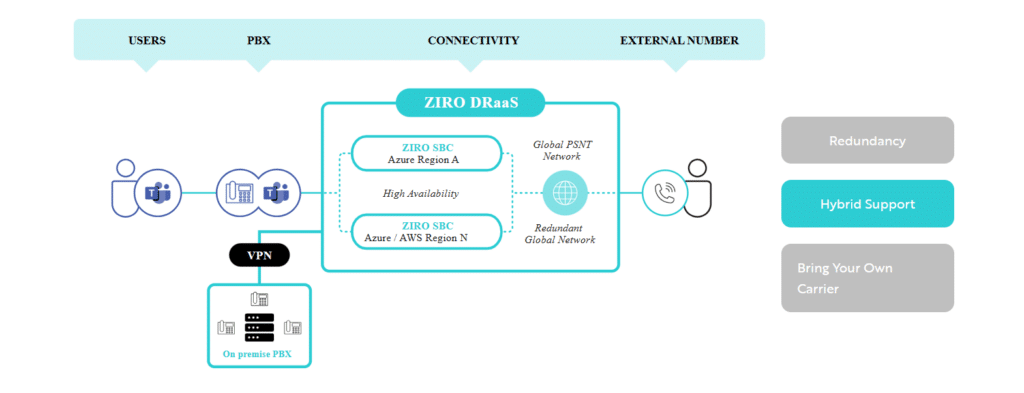
Navigating modern unified communication systems can be complex. Direct Routing simplifies this process by integrating your existing telephony infrastructure with Teams, offering greater flexibility and control over your communication setup.
With Direct Routing, you can maintain existing PSTN contracts, integrate third-party PBX systems, and connect analog devices, all while enjoying the powerful collaboration features Teams has to offer. And in this ZIRO guide, we walk you through the steps to configure Microsoft Teams Direct Routing.
What Is Microsoft Teams Direct Routing?
Direct Routing is a feature in Microsoft Teams that allows organizations to connect their own telephony infrastructure to the platform.
It enables external calls directly through Microsoft Teams by connecting Microsoft Teams to the Public Switched Telephone Network (PSTN), providing full Private Branch Exchange (PBX) voice capabilities for both internal and external calls.
This solution is ideal for organizations that need a PBX or in circumstances where Microsoft’s cloud-only voice solutions (like the Calling Plan) are unavailable or unsuitable.
How to Configure Direct Routing in Microsoft Teams
Step 1: Connect the SBC with Teams Phone and Validate the Connection
This step involves setting up and registering your Session Border Controller (SBC) with Microsoft Teams. The SBC acts as a bridge between your on-premises phone system and Teams, ensuring seamless communication.
- Access the Microsoft 365 Admin Center.
- Navigate to Voice > Direct Routing.
- Click Add and enter the Fully Qualified Domain Name (FQDN) for your Session Border Controller (SBC).
- Configure the SBC settings according to your organization’s requirements.
- Click Save to complete the setup.
Step 2: Enable Users for Direct Routing, Voice, and Voicemail
This step involves enabling the necessary features for users to make and receive calls through Microsoft Teams using Direct Routing. This includes assigning licenses and enabling enterprise voice and voicemail.
a. Create a User and Assign the License
You can create a user in Microsoft 365 either through the on-premises Active Directory and sync it to the cloud or directly in the Microsoft 365 Admin Center.
b. Configure the Phone Number and Enable Enterprise Voice
- i. In the Teams Admin Center, go to Users > Manage Users.
- ii. Select a User and choose Edit under Account General Information.
- Iii. Under Assign phone number, choose Direct Routing from the Phone Number type drop-down options.
- iv. Enter the assigned phone number (and extension if applicable) and apply the settings.
- v. Apply the settings.
ZIRO offers a simpler and more efficient way to assign and manage numbers through the ZIRO Platform for Microsoft. It enables your helpdesk to easily manage end users, including assigning numbers to them with a few clicks.

c. Configure Calls to Go Directly to Voicemail
Configure calls to be sent directly to voicemail by attaching opaque=app:voicemail to the Request URI header. For example, use “sip:user@yourdomain.com;opaque=app:voicemail“.
d. Assign Teams Only Mode to Users
Ensure calls are routed through Teams by assigning users the “UpgradeToTeams” instance of the TeamsUpgradePolicy.
Step 3: Configure Call Routing
This step involves setting up the rules and policies that determine how calls are routed through your SBC. This includes creating PSTN usages, voice routes, and voice routing policies.
a. Creating PSTN Usages
Here, you define the PSTN usages that will be used in voice routing policies:
- In the Microsoft Teams Admin Center, navigate to Voice > Direct Routing.
- In the upper-right corner, select Manage PSTN usage records.
- Click Add, enter the relevant usage records (e.g., US and Canada), and then select Apply.
b. Creating Voice Routes
Next, set up voice routes to define how calls are routed through the SBC.
- Go to Voice > Direct Routing, and select the Voice Routes tab.
- Click Add, provide a name and description for the route, set the priority, and specify the dialed number pattern.
- Under SBCs enrolled (optional), click Add SBCs, select the SBCs to enroll, and then select Apply.
- Under PSTN usage records (optional), click Add PSTN usage, select the records to add, and then select Apply.
v. Click Save.
c. Creating Voice Routing Policies
Next, combine PSTN usages and voice routes into a voice routing policy.
- Navigate to Voice > Voice routing policies, and click Add.
- Enter a name and description for the policy.
- Under PSTN usage records, click Add PSTN usage, select the appropriate usage record, and then select Apply.
- Click Save.
d. Assigning Voice Routing Policies to Users
- Go to Users, select the user, and then click Policies.
- Next to Assigned Policies, click Edit.
- Under Voice routing policy, select the appropriate policy and click Save.
Step 4: Translate Numbers to an Alternate Format
This step involves creating and applying translation rules to ensure phone numbers are formatted correctly for Teams routing. Translation rules are applied at the SBC level and can be managed using PowerShell.
a. Create Translation Rules
- Define rules to translate phone numbers to the required format.
- Use the following cmdlets to manage rules:
New-CsTeamsTranslationRule, Set-CsTeamsTranslationRule, Get-CsTeamsTranslationRule, and Remove-CsTeamsTranslationRule
b. Apply Translation Rules
- Use the cmdlets New-CSOnlinePSTNGateway and Set-CSOnlinePSTNGateway to assign translation rules to SBCs.
- Configure the parameters:
InboundTeamsNumberTranslationRules, InboundPSTNNumberTranslationRules, OutboundTeamsNumberTranslationRules, and OutboundPSTNNumberTranslationRules.
Step 5: Testing and Support
Finally, test call flows to ensure proper functionality.
Use the Teams Admin Center, Microsoft’s Call Quality Dashboard (CQD), and PowerShell cmdlets like Test-CsPhoneNumberAssignment to monitor and troubleshoot as necessary. These tools provide detailed insights into call quality and are powerful tools for diagnosing routing issues.
Also, verify that your SBC is certified and supported by Microsoft. Regularly update and maintain both SBC and Teams configurations to ensure ongoing compatibility and performance.
Best Practices for Microsoft Teams Direct Routing Configuration
Partner with a Direct Routing as a Service Company
Engaging a DRaaS provider can streamline your Direct Routing setup in Microsoft Teams. Our DRaaS solution is supported by ZIRO Managed SBCs, which can be customized to meet any compatibility challenges. Combining this with other ZIRO services, like the ZIRO Platform for Microsoft, gives you complete support and removes the need to train or hire additional staff.

Choose a Reliable Provider
Opt for a certified Session Border Controller (SBC) provider that aligns with your organization’s requirements. Ensure the provider offers robust support and has a proven track record with Direct Routing implementations.
Roll Out Microsoft Teams Internally
Before your Microsoft Teams direct routing configuration, ensure Microsoft Teams is fully deployed and adopted within your organization. This helps users become familiar with the platform and reduces potential issues during the transition.
Complete Your Licensing Requirements
Confirm that all users requiring Direct Routing have the appropriate Microsoft Teams Phone licenses. Ensure your Microsoft 365 subscription includes the necessary features for Direct Routing.
Port Existing Numbers
When porting existing phone numbers, plan the process carefully.
Porting can take several days to complete and requires close coordination with both your current telephony provider and Microsoft. Any delays or miscommunication can result in service interruptions, so double-check all details before initiating the process.
Seamless Microsoft Teams Direct Routing Configuration With ZIRO
Direct Routing in Microsoft Teams offers several benefits for organizations, including flexibility, cost savings, centralized communication, advanced calling features, and improved productivity. However, achieving these benefits relies heavily on your infrastructure and the effectiveness of your implementation.
As a certified Microsoft Solutions Partner specializing in Teams Phone solutions, ZIRO helps reduce the complexity, time, and risk associated with Direct Routing in Microsoft Teams. Our DRaaS solution offers seamless configuration, flexibility, and scalability at a lower cost. Ready to adopt Direct Routing in Microsoft Teams? Contact us today to get started.
Ready to take your unified communications from headache to hassle-free?
No throwing darts at proposals or contracts. No battling through the back-end. No nonsense, no run-around.



